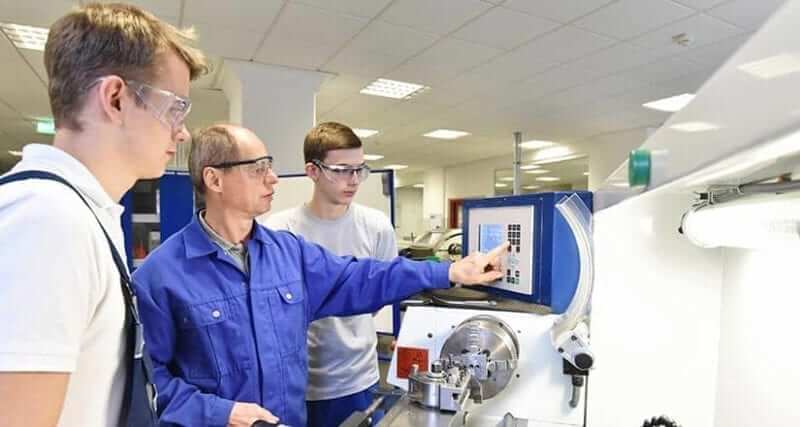Now’s the Time to Invest in Career and Technical Education (CTE)
I was having a conversation with one of my former Language Arts students the other day at the Career & Technical Education Center where I work. He is a senior in high school and currently in his second year of a two-year Computer Networking course. In May, he will take a CISCO Network Certification exam. If he passes, he can either go on to college to pursue a degree, or he can immediately enter the workforce with his certification and earn upwards of $70,000 per year. It doesn’t seem like a hard choice to make. He said he is ready to dive in and start earning money to support himself and his family.
I have another senior who is enrolled in year two of an Electrical program. He worked last summer as an intern for a local electrical company and is currently doing an apprenticeship with the same company. He is earning $17 per hour. Once he graduates in June, he can start to pursue his Journeyman license with his required training hours already complete. The average salary of a Journeyman Electrician in my area right now is $20-30 per hour.
Both of these students have the potential to earn the same salary or a larger salary than I do as a teacher with my Master’s degree and seventeen years of experience. And they will have zero student loan debt to pay back. Considering that as of 2016 the average college student had $37,172 in debt, this is a significant value.
In case you hadn’t heard, February is Career and Technical Education (CTE) Month. Now more than ever, we need to be supporting CTE programs across the country and encouraging high school students to participate in them. Besides being able to earn a good salary without incurring debt, there are three other important reasons CTE is the place to be.
- There is a HUGE need for skilled workers.
The Bureau of Labor Statistics estimates that by 2022, one third or all jobs available will be in construction and health care/personal care. However, right now we do not have enough workers to fill those openings. To further highlight the labor shortage, the Department of Education statistics show that over the next four years in the construction and transportation industry alone, there will be 68% more job openings than people to fill them.
To help fill this shortage, some states are increasing their spending on CTE programs. At the national level, president Trump and many members of Congress have supported the idea of making Pell grants available for shorter job training courses, though this hasn’t happened yet.
In the private sector, groups like Generation T and the Mike Rowe WORKS Foundation are doing what they can to fill the skills gap. Rowe’s foundation has awarded more than $5 million in scholarships to help people train in the skilled trades. His motto bluntly sums up the issue at hand, “America is lending money it doesn’t have to kids who can’t pay it back to train them for jobs that no longer exist. That’s nuts.”
- College isn’t for everyone.
For the last 30 years there has been a nationwide push for high school students to attend college. In fact, funding for higher education at the federal level has gone up 133% to a whopping $150 billion per year. In contrast, funding for non-college or CTE pathways is only $1 billion per year.
With this financial push has come the belief in high schools that students need to go to college to do well in life. Guidance counselors across the country funnel students into classes that are supposed to prepare students for the rigors of college, not for a specific job. As this NPR article highlights, many students go to college just because they feel like they have to in order to live up to society’s expectations, not because they want to. The article perfectly sums up the issue with a quote from Kate Blosveren Kreamer, deputy executive director of Advance CTE: “There’s that perception of the bachelor’s degree being the American dream, the best bang for your buck. The challenge is that in many cases it’s become the fallback. People are going to college without a plan, without a career in mind, because the mindset in high school is just, ‘Go to college.’ ”
Unfortunately, this push to attend college has led to a drop in degree completion rates. The National Center for Educational Statistics found that in 2016 60% of students had completed a Bachelor’s degree at the institution where they started in 2010. Leaving college without a degree leads to lots of time and money wasted for these students and a lot debt they sometimes can’t pay back.
- There is satisfaction in being a skilled tradesman.
Our country tends to revere white-collar professions like doctors, lawyers, businessmen, etc. and there is nothing wrong with pursuing such a career if you are passionate about it. But we all also know the amazing value of an HVAC technician when your furnace has stopped working in the dead of winter or of a plumber when your toilet isn’t working. These skilled tradesman are every bit as important to keeping our lives running smoothly.
There is also a lot of satisfaction for the tradesman in putting in a good day’s work and making someone’s life better in the process. In a blog for Generation T, Jason Burns drives home this point as he describes the cycle of becoming a skilled tradesman: “Old Timers” transfer the years of knowledge, safety skills, and instill the pride of those tradesmen that have been working with their hands all their lives into this new generation of tradesmen and women…Young men and women in our schools and communities learn a trade and are so proud of their craft that it impacts their families and surroundings using those skills.”
By this point, I hope I’ve managed to convince you of the value of CTE programs, and I hope you will support the local CTE centers in your area. And to parents of high schoolers, I hope that you keep an open mind about your children’s future. In my many years of teaching, it has become clear to me that college really isn’t for everyone, no matter what some guidance counselors may say, and there are so many skilled trades that can lead to not only solid future employment for your children, but also a sense of pride and satisfaction in what they do.






Comments are closed.